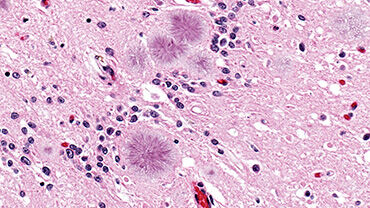European Creutzfeldt-Jakob Disease Surveillance Network (EuroCJD)
History
The EuroCJD network was established in 1993 by seven countries to conduct epidemiological surveillance for Creutzfeldt Jakob disease and was subsequently enlarged to include more countries and a research component, funded by DG Research (now DG R&I) and DG SANCO (now DG SANTE) within the European Commission. The surveillance of variant Creutzfeldt Jakob disease (vCJD) was regulated in the EU in 2000, and the network was evaluated and responsibility was transferred to the European Centre for Disease Prevention and Control (ECDC) in 2007. The EuroCJD network is now comprised of nominated National Focal Points (NFPs) and Operational Contact Points (OCPs) for Transmissible Spongiform Encephalopathies (TSEs) in the EU/EAA Member States, and coordination is funded by the ECDC and outsourced to the National CJD Research & Surveillance Unit based in Edinburgh.
Legal basis for surveillance
A network for the epidemiological surveillance and control of communicable diseases in the Community was laid down in Decision No 2000/96/EC of 22 December 1999, and elaborated on in Decision No 2119/98/EC . This lists variant Creutzfeldt Jakob disease (vCJD) under other foodborne diseases to be progressively covered by the Community network. The legal basis for vCJD surveillance is now retained under Decision No 1082/2013/EU of the European Parliament and of the Council of 22 October 2013 on serious cross-border threats to health. This came into force on 6 November 2013.
Decision No 2012/506/EC contains the latest version of the case definitions for reporting communicable diseases to the Community network, including a case definition for vCJD. Regulation (EC) No 851/2004 establishes ECDC charging it, among other tasks, with the integrated operation of dedicated surveillance networks and with the identification of emerging health threats.
Surveillance objectives and methods
(as approved by the ECDC Advisory Forum in October 2008 and September 2010)
General surveillance goals:
- Monitor trends over time to assess the present situation and compare trends across Member States.
- Detect and monitor any outbreaks with respect to source, time, person, population and place to provide a rationale for public health action.
- Contribute to the evaluation and monitoring of prevention and control programmes to provide the evidence for recommendations to strengthen and improve these programmes at the national and European level.
- Contribute to the assessment of the burden of communicable diseases on the population.
- Generate hypotheses on (new) sources, modes of transmission and groups most at risk and identify needs for research.
Specific objectives of variant Creutzfeldt Jakob Disease surveillance supported by the EuroCJD Network:
- To identify and characterise clinical-pathological phenotype and demographic features of all cases of vCJD.
- To standardise diagnosis and classification of vCJD by applying common agreed diagnostic criteria.
- To identify and monitor risk factors in all cases.
- To monitor trends in incidence and mortality across Member States and in the EU.
- To identify any potential new links between TSEs in humans and animals.
Case definitions:
Incident cases of vCJD are defined as probable according to the EU case definition. Case confirmation depends on post-mortem neuropathology examination.
Surveillance of vCJD at ECDC In 2012 reporting of vCJD, including all historical cases was established through the European Surveillance System (TESSy) database. Currently, Member States are requested to report to TESSy all new incident probable or definite cases upon official notification
Contact us
The network co-ordinators can be contacted at ECDC at FWD.ECDC@ecdc.europa.eu
Governance
EuroCJD network members are experts on Transmissible spongiform encephalopathies (TSEs) from EU/EEA countries, who are nominated by their designated national authorities (“competent bodies” according to Regulation (EC) No 851/2004 , Article 2a). The network is now comprised of National Focal Points (NFPs), who are the primary contact point for TSEs in each Member State, and Operational Contact Points (OCPs) who are nominated on the basis of their technical and operational expertise in vCJD and other TSEs. The NFPs and OCPs together ensure that the EuroCJD network has comprehensive surveillance coverage and a range of expertise on all aspects of vCJD and prion disease in the EU.
The network is coordinated by ECDC through the appointed contractor, the National CJD Research & Surveillance Unit based in Edinburgh, Scotland, with the support of a coordination committee (CC) consisting of 10 elected network members among the nominated NFPs and OCPs . The CC typically meets every year and advises ECDC on ways to strengthen and improve vCJD surveillance and prevention in the EU/EEA. The CC also reviews technical documents relevant to the network.
Coordination Committee members
Chair: Robert G. WILL, University of Edinburgh (UK)
- Cornelia M. VAN DUIJN, Erasmus University Medical School (The Netherlands)
- Gabor G. KOVACS, Semmelweis University (Hungary)
- Hans BLYSTAD, Norwegian Institute of Public Health (Norway)
- Herbert BUDKA, Clinical Institute for Neurology, Medical University of Vienna (Austria)
- Inga ZERR, Georg-August University, Göttingen (Germany)
- Jean-Philippe BRANDEL, Cellule Nationale de référence des maladies de Creutzfeldt-Jakob Groupe Hospitalier Pitié-Salpêtrière (France)
- Jesus de PEDRO CUESTA, National Centre of Epidemiology - Instituto de Salud Carlos III (Spain)
- Maurizio POCCHIARI, Istituto Superiore di Sanita (Italy)
- Pawel P. LIBERSKI, Medical University of Lodz (Poland)
Network meeting
The EuroCJD network meeting is held biannually and constitutes a valuable platform for:
- the assessment of the latest scientific and diagnostic findings and developments in the field of CJD;
- the assessment of their impact on the needs of future surveillance; and
- sharing country-specific experience, case studies and public health activities.
All nominated EU/EAA NFPs and OCPs are invited. Non-network members representing public health institutions from non EU/EEA countries may also be invited to ensure continuity of a unique international platform for reviewing cases and discussing clinical findings and diagnostic results.
The EuroCJD network has agreed the following specific objectives that complement and support the overarching aims for variant Creutzfeldt Jakob Disease surveillance:
- Identification of all cases of vCJD in EU
- Provision of accurate data on worldwide incidence of vCJD
- Assessment and identification of risk factors including but not limited to genetic background linked to vCJD cases
- Identification of vCJD caused by secondary transmission (e.g. blood transfusion)
- Provision of advice and support to Member States on diagnosis and classification of suspected cases, and be a reference centre for vCJD in EU
- Provision of an early warning system to ECDC
- Dissemination of information on vCJD
- Assessment and development of diagnostic investigations in vCJD
- Identification of novel forms of human prion disease and potential links to animal prion diseases
- Provision of data and, with informed consent, samples or tissues, for further research of vCJD





